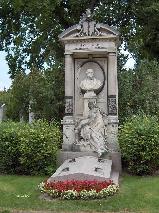Hasenauer, Carl, Freiherr von |
| ARCHITECT (AUSTRIA) |
|
BORN 20 Jul 1833, Wien - DIED 4 Jan 1894, Wien GRAVE LOCATION Wien: Zentralfriedhof, Simmeringer Hauptstraße 234, Simmering (Gruppe 32 A, Nummer 33) |
|
Carl von Hasenauer studied in Braunschweig and in Vienna, where August von Siccardsburg and Eduard van der Nüll were his teachers at the Academy of Fine Arts. In 1854 he received the Academy Prize for Architecture. He is best known for his monumental buildings around the Ringstrasse in Vienna that were created in a Neo-Baroque style. In 1873 he was the chief architect of the World Exhibition in Vienna and in the same year he was enobled. Von Hasenauer designed the complex with the Maria-Theresia Memorial, the Kunsthistorisches Museum and the Naturhistorischesmuseum in Vienna together with Gottfried Semper. For the Burgtheater he designed the facades. After a conflict with Semper he managed the building of the new Hofburg on his own from 1881 until his deat (it was completed in 1913). Between 1882 and 1886 he built the Hermes villa, a gift from emperor Franz Joseph for his wife. Von Hasenauer died in 1894 in Vienna. He was buried at the Evangelical Cemetery in Matzleinsdorf but on 24 May 1894 his remains were transferred to the Zentralfriedhof. His monument was created by Otto Hofer with a sculpture by Johannes Benk. Related persons • was teacher of Hegele, Max • was pupil of Nüll, Eduard van der • was teacher of Olbrich, Josef Maria • cooperated with Semper, Gottfried • was influenced by Semper, Gottfried • was pupil of Sicard von Sicardsburg, August |
| Images |
Sources • Winkler Prins Encyclopedie (editie 1909), 1909 • Carl von Hasenauer - Wikipedia (DE) |



